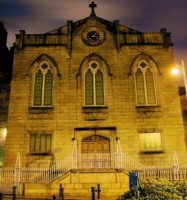
A Snippet of Dublin History (Part 9) – Smock Alley – Betty Brunkard Talks about the history of this famous Dublin theatre
Smock Alley was the principal theatre in Ireland for almost a century and was situated on a site known as “Preston’s Inns”. In 1661, John Ogilby, obtained the title of Master of the Revels in Ireland. This position gave him the right to build one or more theatres in Dublin. He proceeded to have a theatre erected on a portion of the Blind Quay, described in a document of 1662 as “a house and piece of ground on the quay, heretofore called the White House, as a part whereof the new theatre and other houses are built.”
The cost of building this theatre was two thousand pounds. The theatre was well attended, but on Saint Stephen’s Day 1671, the upper gallery gave way, because of overcrowding and three people were killed.
In 1692, Viscount Sydney, while Lord Lieutenant, is stated to have promoted plays, sports and entertainment in the theatre, to divert the attention of the people from the conduct of himself and his agents. Dr. William King, Archbishop of Dublin, sent a letter to James Bonnell stating that the young men of the city” attended more to the Play – house than to their studies.
” A description of the theatre at the time says that “the Play – house was a place very contrary to its owners; for they on their outsides make the best show: but this is very ordinary in its outward appearance, but looks much better on the inside, with its stage, pit, boxes, two galleries, lattices and music loft; it stands in a dirty street called Smock Alley, which is no unfit name for the place.”
During a production of Shadwell’s play “The Libertine” in 1701, part of the theatre fell wounding and killing several people. This accident was regarded as a retribution for the decadent nature of the play being performed!
From its establishment the Manager of Smock Alley theatre received an annual sum of one hundred pounds from the government, for performances on certain anniversary nights. These were regarded as highly fashionable affairs and were attended by The Lord Lieutenant and other state officials. In 1735, the theatre was demolished and rebuilt, since it now had opposition of a recently opened theatre in Aungier Street.
The new Smock Alley theatre was opened on Thursday, 11th December 1735 and, because of its central location, had a great advantage over its rival in Aungier Street. The theatre was crowded each night and turned away as many people as was admitted. This popularity waned in the 1740’s, when theatre was regarded as common and shunned by the people. One part of Smock Alley theatre became a bear garden and the other part a brothel. The theatre became an unruly place. It was not uncommon to see more than 100 people on stage, audience mingling with actors.
The musical performances became a problem, with audience requesting different pieces of music. The musicians were playing each tune in turn, but one part of the audience felt the other part was being treated better than them. This resulted in glass bottles and stones being hurled at the musicians, who decided that it would be more prudent for them to perform behind scenes.
Thomas Sheridan became Manager in 1745 and he reformed the theatre. He paid actors a regular wage and increased the admission fee for each person. The result was that only the wealthy could pay and the behaviour became much improved.
In November 1760, Henry Missop, the son of the Protestant Rector of Tuam, became Manager. He was successful at first, but as a result of a gambling addiction, squandered the proceeds and so began the descent of the theatre. Before this the theatre was described by a tourist as one of the most elegant and best constructed theatres of its time. The curtain displayed a painted scene of the Parliament building and the front of Trinity College, with various figures representing the Arts. Over the curtain was a representation of a ship called the “Smock Alley Frigate, “sailing into port with “All’s well that ends well” inscribed on its sails.
However, by 1780 the theatre had a debt of 3615 pounds. This proved to be its undoing and around 1790 Smock Alley theatre was converted into a warehouse to store whiskey and flour by merchants James and Charles Ferrall. Eventually this building fell into decay and in 1815, the Catholic Parish Church of Saints Michael and John was erected on the site. The only remaining part of the original Smock Alley theatre was a portion of an arched passage on the south east side of the church.
In 1750, Michael Duff opened the “Kings Arms” in a house which once adjoined the theatre. This inn was capable of holding over two hundred people and the “Society of Free Citizens” used to assemble here in 1774, with Napper Tandy as president.








